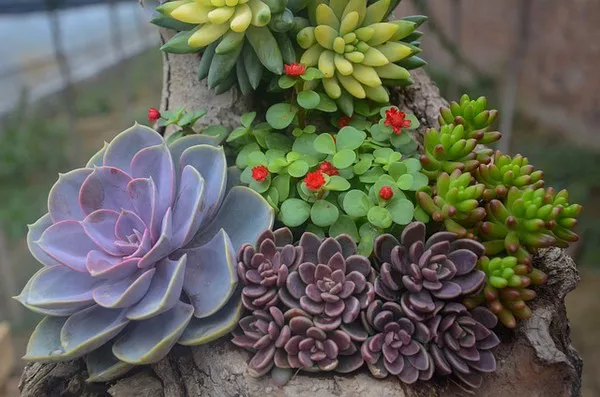Succulents, with their striking shapes and vibrant hues, have captured the hearts of plant enthusiasts worldwide. From the resilient Aloe Vera to the delicate Echeveria, these desert-dwellers offer an array of visual delights. While admired for their distinctive foliage, succulents also have the ability to surprise with their stunning flowers. Delving into the intricate mechanisms behind succulent blossoming reveals a fascinating journey of adaptation and survival.
The Intricacies of Succulent Flowering
In the world of botany, succulents stand out not only for their ability to thrive in arid conditions but also for their diverse and captivating blooms. Unlike many other flowering plants, succulents have evolved unique strategies to conserve water, which profoundly influences their flowering patterns.
Adaptations to Arid Environments
Succulents are renowned for their water-storing capabilities, primarily achieved through specialized tissues such as succulent leaves and stems. These adaptations allow them to survive in environments where water is scarce and unpredictable. However, this arid habitat presents challenges for flowering, as the energy required for blooming must be carefully managed to ensure survival during periods of drought.
Triggering Flowering: Understanding the Role of Environmental Cues
While succulents are hardy plants, their flowering is often triggered by specific environmental cues. Factors such as temperature, light, and moisture play pivotal roles in initiating the flowering process. For many succulents, a period of cooler temperatures or changes in day length signals the onset of flowering, ensuring that blooms coincide with favorable growing conditions.
The Role of Photoperiodism
Photoperiodism, the response of plants to the length of daylight and darkness, plays a crucial role in regulating flowering in succulents. In regions with distinct seasons, such as deserts, succulents may rely on changes in day length to time their flowering. Shorter days and longer nights can act as a signal for certain species to enter their flowering phase, ensuring that blooms occur when environmental conditions are optimal for pollination and seed production.
Water Stress and Flowering
Water availability also influences succulent flowering, with periods of drought often triggering blooming in a phenomenon known as drought-induced flowering. When succulents experience water stress, they may divert resources towards reproductive efforts as a survival strategy. By producing flowers during times of drought, succulents increase their chances of cross-pollination and seed dispersal, enhancing their reproductive success even in challenging conditions.
The Mechanics of Succulent Blooms
Succulent flowers exhibit a remarkable diversity of forms, colors, and fragrances, reflecting adaptations to their pollination mechanisms and ecological niches. From the intricate symmetry of Echeveria blossoms to the bold hues of Kalanchoe inflorescences, each succulent species has evolved unique floral structures to attract pollinators and ensure successful reproduction.
Pollination Strategies
The success of succulent flowering relies heavily on effective pollination, which is facilitated by a variety of agents including insects, birds, and even bats. Many succulents have coevolved with specific pollinators, developing flowers that are tailored to attract and reward these visitors. Brightly colored petals, sweet nectar, and enticing fragrances are common adaptations that lure pollinators and ensure the transfer of pollen between flowers.
Adaptations for Arid Environments
In arid environments where succulents thrive, pollinators may be scarce, prompting these plants to employ alternative strategies for reproduction. Some succulents are capable of self-pollination, while others produce flowers with mechanisms for delayed self-fertilization, reducing their dependence on external pollinators. These adaptations enhance reproductive success in environments where pollinator activity may be limited.
The Role of Hummingbirds and Other Pollinators
While insects are the primary pollinators for many succulents, certain species have formed mutualistic relationships with birds such as hummingbirds. These agile flyers are attracted to the bright colors and copious nectar produced by succulent flowers, making them effective pollinators for species such as Agave and Aloe. By catering to the preferences of specific pollinators, succulents increase the likelihood of successful pollination and seed production.
The Beauty of Succulent Flowers
Beyond their ecological significance, succulent flowers captivate with their sheer beauty and diversity. From the cascading blooms of Sedum ‘Autumn Joy’ to the towering inflorescences of Echinopsis cactus, each succulent species offers a unique floral display that adds a touch of elegance to gardens, landscapes, and indoor spaces alike.
Cultivating Succulent Blooms
For enthusiasts eager to witness the spectacle of succulent flowering, cultivating these plants can be a rewarding endeavor. Providing optimal growing conditions, including ample sunlight, well-draining soil, and occasional waterings, encourages healthy growth and blooming. Additionally, understanding the specific needs of each succulent species ensures that their flowering potential is maximized, whether grown indoors or in outdoor gardens.
Conclusion
Succulents, with their remarkable adaptations to arid environments, offer a fascinating glimpse into the complexities of plant biology. From the triggering of flowering by environmental cues to the intricate mechanisms of pollination, succulent blossoming is a testament to nature’s ingenuity. By unraveling the mysteries behind succulent flowering, we gain a deeper appreciation for these resilient plants and the beauty they bring to our world.


